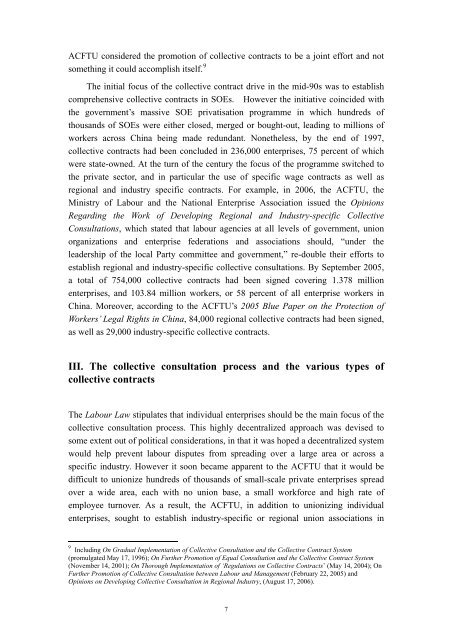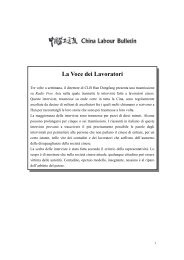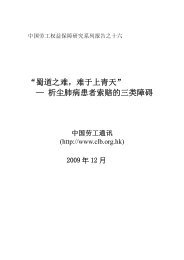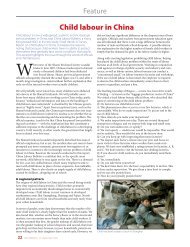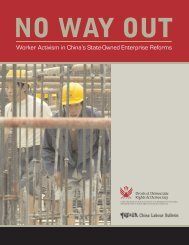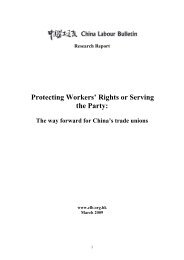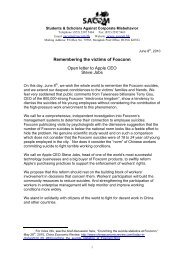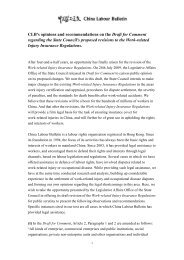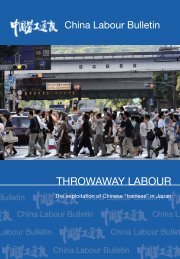here - China Labour Bulletin
here - China Labour Bulletin
here - China Labour Bulletin
Create successful ePaper yourself
Turn your PDF publications into a flip-book with our unique Google optimized e-Paper software.
ACFTU considered the promotion of collective contracts to be a joint effort and not<br />
something it could accomplish itself. 9<br />
The initial focus of the collective contract drive in the mid-90s was to establish<br />
comprehensive collective contracts in SOEs. However the initiative coincided with<br />
the government’s massive SOE privatisation programme in which hundreds of<br />
thousands of SOEs were either closed, merged or bought-out, leading to millions of<br />
workers across <strong>China</strong> being made redundant. Nonetheless, by the end of 1997,<br />
collective contracts had been concluded in 236,000 enterprises, 75 percent of which<br />
were state-owned. At the turn of the century the focus of the programme switched to<br />
the private sector, and in particular the use of specific wage contracts as well as<br />
regional and industry specific contracts. For example, in 2006, the ACFTU, the<br />
Ministry of <strong>Labour</strong> and the National Enterprise Association issued the Opinions<br />
Regarding the Work of Developing Regional and Industry-specific Collective<br />
Consultations, which stated that labour agencies at all levels of government, union<br />
organizations and enterprise federations and associations should, “under the<br />
leadership of the local Party committee and government,” re-double their efforts to<br />
establish regional and industry-specific collective consultations. By September 2005,<br />
a total of 754,000 collective contracts had been signed covering 1.378 million<br />
enterprises, and 103.84 million workers, or 58 percent of all enterprise workers in<br />
<strong>China</strong>. Moreover, according to the ACFTU’s 2005 Blue Paper on the Protection of<br />
Workers’ Legal Rights in <strong>China</strong>, 84,000 regional collective contracts had been signed,<br />
as well as 29,000 industry-specific collective contracts.<br />
III. The collective consultation process and the various types of<br />
collective contracts<br />
The <strong>Labour</strong> Law stipulates that individual enterprises should be the main focus of the<br />
collective consultation process. This highly decentralized approach was devised to<br />
some extent out of political considerations, in that it was hoped a decentralized system<br />
would help prevent labour disputes from spreading over a large area or across a<br />
specific industry. However it soon became apparent to the ACFTU that it would be<br />
difficult to unionize hundreds of thousands of small-scale private enterprises spread<br />
over a wide area, each with no union base, a small workforce and high rate of<br />
employee turnover. As a result, the ACFTU, in addition to unionizing individual<br />
enterprises, sought to establish industry-specific or regional union associations in<br />
9 Including On Gradual Implementation of Collective Consultation and the Collective Contract System<br />
(promulgated May 17, 1996); On Further Promotion of Equal Consultation and the Collective Contract System<br />
(November 14, 2001); On Thorough Implementation of ‘Regulations on Collective Contracts’ (May 14, 2004); On<br />
Further Promotion of Collective Consultation between <strong>Labour</strong> and Management (February 22, 2005) and<br />
Opinions on Developing Collective Consultation in Regional Industry, (August 17, 2006).<br />
7


